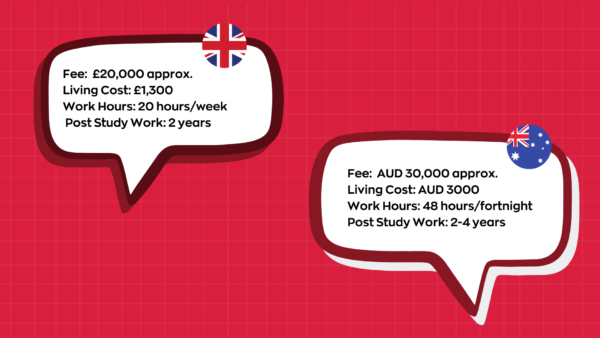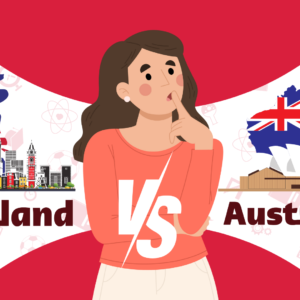Both the UK and Australia are extremely popular destinations, known for their world class education systems, research infrastructure and post-study work opportunities. They have welcomed students from all over the world, especially from India, for decades.

Here is the UK and Australia as international study destinations at a glance.
|
The United Kingdom |
Australia |
| Top Universities |
1. University of Cambridge
2. University of Oxford
3. Imperial College London |
1. University of Melbourne
2. University of New South Wales
3. University of Sydney |
| Duration |
Bachelor’s: Typically 3 years
Master’s: 1 year |
Bachelor’s: 3 years with an optional 4th research year
Master’s: 2 – 3 years |
| Top Choice of Subjects |
Medicine and Dentistry
Veterinary Medicine
Education
Law
Business Management
Architecture
Social Sciences
Humanities |
Engineering
Accountancy and Finance
Business Management
Tourism and Hospitality Management
Computer Science and Information Technology |
| Average Tuition fees |
UG: £22,200 (INR 23,42,677.20)
PG: £17,109 (INR 18,05,444.33) |
AUD 22,000 – 50,000 for most typical bachelor’s and master’s programs (11.8 – 26.8 lakhs INR) |
| Cost of Living per month |
£1,300 (INR 1,37,216.37) |
Around AUD 3,000 (INR 1.6 lakhs) |
| Work while you study |
Allowed up to 20 hours per week |
Allowed up to 48 hours a fortnight |
| Post-Study Work |
Graduate Immigration Route – 2 year stay |
Temporary Graduate visa (subclass 485) – 2-4 years |
How does one choose between the two?

Your choice primarily depends on your course and the university most suited for your choice of studies. Everything else is secondary. Is the university at the cutting edge of your field? Is the university curriculum matching your needs? Where does the university stand in terms of global recognition? These are the questions you must ask first while choosing. Then comes all the other factors such as
- The teaching-learning style of the department you are applying to
- The costs involved
- The admissions criteria that you need to meet
- Immigration policies and job opportunities and
- Attitudes towards international students in the university/ city/ country.
Keeping this in mind, here are the pros and cons of studying in the UK vs Australia. Let us dive right in.
1. Quality of Education
When it comes to higher education, both countries are popular study destinations, especially for students from India. UK and Australian universities have a global reputation and are renowned for their state-of-the-art infrastructure for teaching and research. Both nations’ universities are ranked in the top 100 in QS World University Rankings list. UK universities rank slightly higher, partly due to its academic legacy and its history of higher education. This also makes UK universities slightly more competitive when compared to their Australian counterparts (depending on the choice of course, of course!).
 |
UK: The academic heritage and renown of the UK needs no separate validation. Two of the oldest and world-class universities are located here – The Universities of Oxford and Cambridge. Besides these two giants, most of the universities in the UK have a long standing history of providing well-rounded higher education to its students. Here are the top 10 universities in the UK according to 2024 QS World University Rankings. |
| S.No |
World Ranking |
University |
| 1 |
2 |
University of Cambridge |
| 2 |
3 |
University of Oxford |
| 3 |
6 |
Imperial College London |
| 4 |
9 |
UCL |
| 5 |
22 |
University of Edinburgh |
| 6 |
32 |
University of Manchester |
| 7 |
40 |
King’s College |
| 8 |
45 |
London School of Economics and Political Science (LSE) |
| 9 |
55 |
University of Bristol |
| 10 |
67 |
University of Warwick |
 |
Australia: As of January 2024, 567,505 international students chose Australian courses for their higher education, of which a majority of them were from China, India and Nepal. In the last few decades, Australia has created a mark as one of the top global ed destinations with world class universities that offer excellent academic programmes, research opportunities, and a vibrant campus life. Here are the top 10 Australian universities according to 2024 QS World University Rankings. |
| S.No |
World Ranking |
University |
| 1 |
14 |
University of Melbourne |
| 2 |
19 |
University of New South Wales |
| 3 |
19 |
University of Sydney |
| 4 |
34 |
Australian National University |
| 5 |
42 |
Monash University |
| 6 |
43 |
University of Queensland |
| 7 |
72 |
University of Western Australia |
| 8 |
89 |
University of Adelaide |
| 9 |
90 |
University of Technology Sydney |
| 10 |
130 |
Macquarie University |
2. Flexibility of university and courses
 |
UK: Universities in the UK are made of “colleges” dedicated to specific subjects or departments. You apply to a specific college and a course rather than to the university as a whole for specific courses. Due to its 3-year undergraduate schedule, most schools do not give you the option of trying out a few courses and then declaring your speciality. Courses are typically theory oriented with emphasis on depth. You will choose your course before entry and continue to specialise.
For example, let’s say you choose Chemistry. Your first year will cover general topics under the banner. In the second year, you can choose a range of topics within “Chemistry” and choose a specialisation such as biochemistry or molecular chemistry in your third year. You might take a course or two from Physics or Biology but that is the extent of flexibility. |
 |
Australia: Australian universities are like the midpoint between the formal English system and the more modern USA higher education system. Some universities follow the traditional practice where you are expected to declare your major in the beginning and choose courses around your major. However, there are some universities, like the University of Melbourne, for instance, that allow you to undertake some foundation courses before choosing your major.
Moreover, most universities give you the option of a 4th research year as a part of the bachelor’s programme. You can complete it in three years and exit with a B.A. or a B.Sc degree or extend into the fourth year and graduate with an Honours degree and substantial research to your name. For those interested in entering the world of research and academia, this is the most commonly used pathway. |
3. Duration of Study
 |
UK: Degrees in the UK are shorter when compared to the US or even other parts of Europe. A bachelor’s degree is typically 3 years while a postgraduate programme can be completed within the span of a year. You can gain a bachelor’s and a master’s degree in the same time you get a bachelor’s honours in the land down under. While this is an advantage, it also means that the programme will be intensive and will require a lot of academic rigour. You will not have a lot of flexibility around deadlines or long breaks. |
|
 |
Australia: Like the UK, undergraduate programmes are typically 3 years with an optional 4th year to graduate with honours. Masters by coursework is usually 2 years while research masters can take up to 3 years. The extended duration is both a pro and a con. You get to spread your academic workload in a more balanced fashion when compared to the UK. However, it also means an additional year of tuition and costs of living that you will have to bear. |
4. Cost of Study
Unlike New Zealand which is a noticeably cheaper option, the costs of study in the UK and Australia are more or less similar. If you want to split hairs, the UK is on the marginally higher side, especially when it comes to undergraduate study. As a student going from India, be it UK or Australia, it is natural to subconsciously multiply your expenses by ~ 100 or ~ 50 to see how much it translates into rupees.
 |
- Average tuition for undergraduate study: 22,200 GBP (INR 23,42,677.20)
- For Postgraduate study: 17,109 GBP (INR 18,05,444.33)
|
 |
- AUD 22,000 – 50,000 for most typical bachelor’s and master’s programs (11.8 – 26.8 lakhs INR)
|
These are median averages and are bound to change depending on the choice of programme. Please note that courses such as Medicine, Dentistry, Nursing or Veterinary Sciences have a significantly higher tuition.
5. Cost of Living
As with tuition, the cost of living in the UK and Australia is also comparable. It is practically impossible to choose one as significantly higher and lower. It depends on the city, the nature of your accommodation and your lifestyle choices. However, when it comes to healthcare systems, both countries have excellent provisions by the government – the NHS in England and Medicare in Australia.
 |
UK: According to the British Council, except for London, the average cost of living is about £1,100 (INR 1,16,106.16) per month. If you are living in London, you can add another £200-300 to your monthly expenses. |
 |
Australia: According to the “Cost of Living Calculator” of Study Australia (the government’s official website for international education, the average cost of living in cities such as Adelaide, Melbourne or Perth is about AUD 2,700 (INR 1.45 lakhs) per month. If you are living in Brisbane or Sydney, you add AUD 300 – 500 per month. |
The following cost of living comparison has a detailed break up of living costs incurred in each of the countries.
6. Teaching – Learning Practices
 |
UK: Universities in the UK are relatively more formal with clear hierarchies in place. Tests are conducted typically at the end of the semester or the year to monitor the student’s progress. The culture in most universities is to allow students their own study methods. In addition to the lectures, the UK education system also has the practice of tutorials, where a small group of students interact closely with a graduate or a doctoral student as part of the study. This provides one-on-one attention and builds research interest in undergraduate students. |
 |
Australia: Classrooms are more informally organised with some professors even allowing their students to use their first names. The teaching-learning process is more liberal, where the freedom and responsibility is placed on your shoulders from the start. Most of the courses include a practical component such as research or internships or co-ops so as to not limit the learning process to the classroom. |
7. Post-Study Work and Immigration
 |
UK: Finding a job in the UK can be challenging, considering the level of competition and the number of international students that flock the country. However, certain specialised fields are in demand and are covered in detail in the following section.
On completion of your study, you can take the Graduate Immigration route and stay in the UK for up to two years and work or look for work. There is no limit on salary and therefore offers flexibility. You are eligible to apply on completion of both bachelor’s or master’s degree programmes. On completion of the two years, you can upgrade to a Tier 2 Skilled Visa under the sponsorship of the organisation that you work for. |
 |
Australia: The job market is quite competitive and requires you to be highly skilled, communicate effectively and have the right qualifications for organisations to choose you over the locals. It is, however, not impossible to find jobs and establish your career in the land down under.
When it comes to the immigration policy, Australia’s is more flexible than that of the UK. On completion of a degree from an Australian institution, an international student can apply for Temporary Graduate visa (subclass 485) under the Post-Study Work stream. Depending on your degree, you will be allowed to stay and work for a period of 2-4 years. |
8. Wages and quality of life
Wages or salary depend on a number of factors including the industry, your qualification, designation or your work experience. That said, the general salary in Australia tends to be marginally higher than that of the UK. In certain areas where there are worker shortages, salaries in Western Australia can be 50% higher than those in the UK.
 |
UK: The national minimum wage is £11.44 (INR 1,177.57) per hour. |
 |
Australia: The national minimum wage is AU $23.23 (INR 1,246.02) per hour
Looking at salaries, if you are in the middle or high income groups, then the quality of life is almost the same. However, for the lower income groups, Australia offers a better quality of life and work life balance. |
9. Culture
 |
UK: The United Kingdom is made of four different countries – England, Scotland, Wales and Northern Ireland. This makes its culture extremely diverse. The general tone is comparatively more formal. Work and organisations are typically more rigidly structured and hierarchical. Be it history, sports or the UK pub culture, life in the UK as an international student can be full of rich experiences. |
 |
Australia: Any description of the land down under brings out Aussies’ sense of informality and easy going nature who are mostly welcoming to immigrants. The Australian coastline offers scenic beauty and tons of adventure activities for those inclined to explore the wild. Despite its high-tech cities, the wilderness is an essential part of Australian culture. Another is the Aussie slang that might make an outsider wonder what language is being spoken! |
10. Weather
If weather is a significant factor in your decision making, Australia wins hands down! The UK is known for its unpredictable, dreary weather while coastal Australia is warm, bright and sunny. Central Australia is primarily a desert and can get uncomfortably hot in summers. In Australia, you will have to get used to a cold June while December and January can get quite warm. White Christmas is not an Australian thing at all (neither is it Indian!).
Winner: A Tie
Both countries have their own set of pros and cons and it is impossible and impractical to choose, based on general advantages and disadvantages. These are to help you mentally prepare for what to expect when you go to the country of your choosing. However, if you run through the parameters with a specific course and university in mind, you will be able to judge which of the two is better suited for you.
























